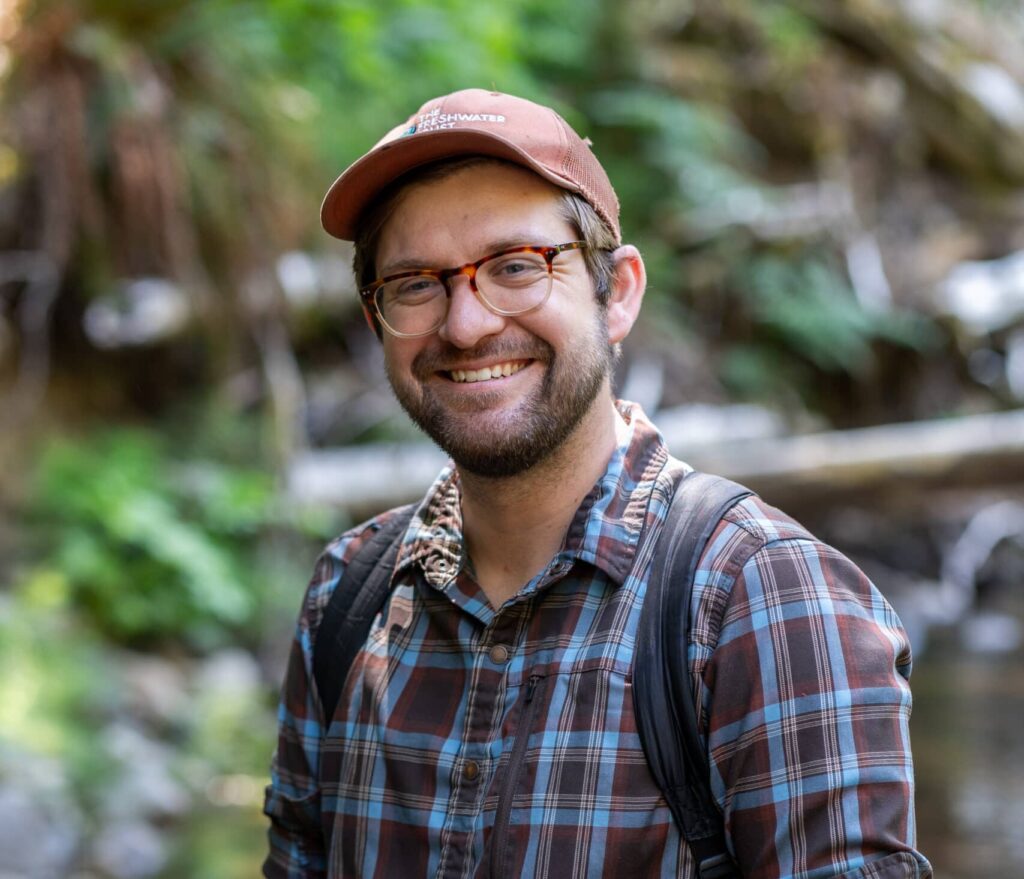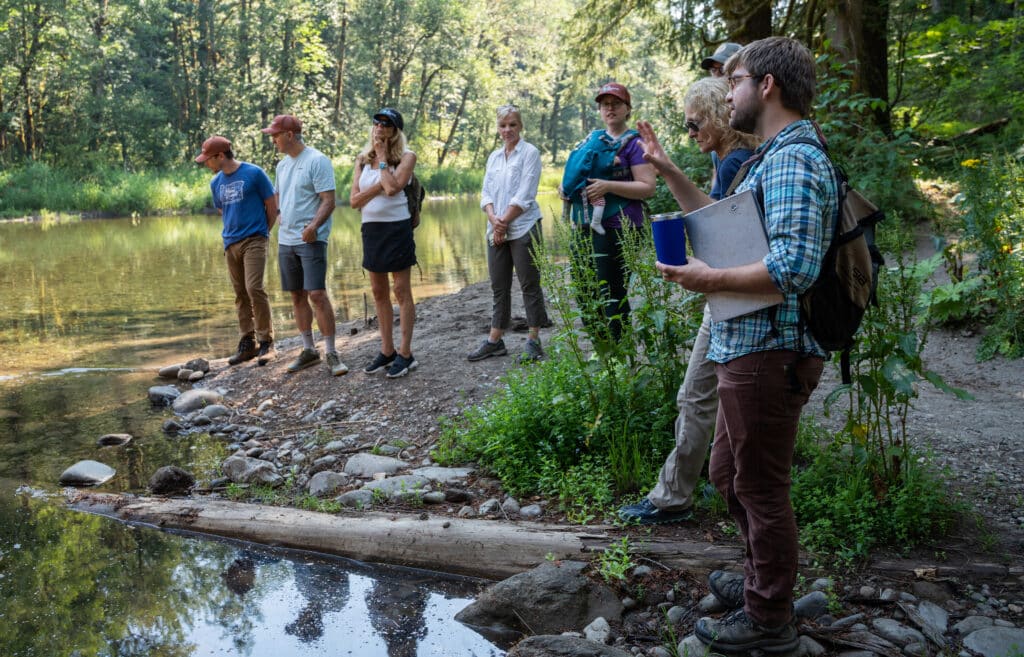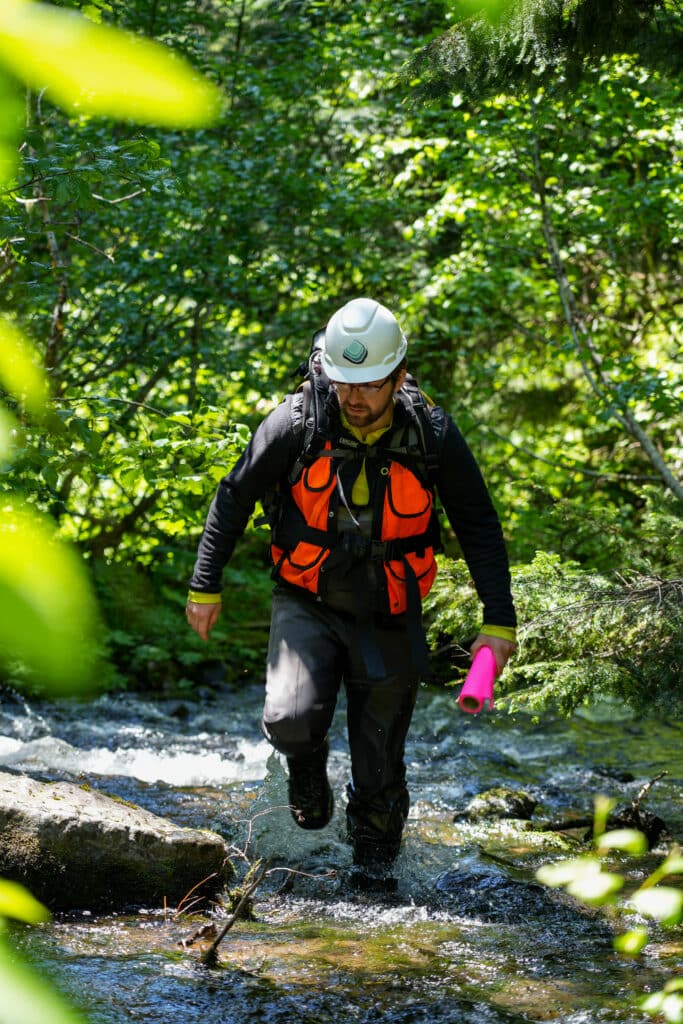Q&A with Daniel Baldwin, Restoration Project Manager
July 31, 2023
We recently sat down with Daniel Baldwin, Restoration Program Manager for The Freshwater Trust to ask him some questions about his work. Daniel has an impressive background in research focusing on drone-based remote sensing and evaluating the long-term geomorphic response of rivers to restoration projects. He holds a bachelor’s degree in Environmental Studies and a master’s degree in Physical Geography from the University of Oregon, with an emphasis on fluvial geomorphology and Geographic Information Systems (GIS).

In two sentences, tell us what you do at The Freshwater Trust.
I work primarily on habitat projects (large wood placement, side channel reconnection, and floodplain enhancement) that benefit salmon, steelhead, and other aquatic species in Oregon’s Sandy Basin. My job involves helping with both the implementation side of things and the post-project monitoring, which tracks the physical and biological response to our work.
What’s the most important thing you’re working on right now?
Right now I’m getting started on our as-built surveys of large wood that we installed with a helicopter earlier this summer. Capturing those baseline conditions is how we can prove to our funders that we did what we set out to do, and it provides an important reference point down the line for adaptive management. There’s no one-size-fits-all approach to restoration, and the more you can learn about the specifics of your watershed, the better work you’re going to be able to do as a restoration practitioner.
What’s something that’s happening at the organization right now that you are very excited about?
Over the past year and a half, TFT has been working with the Bureau of Land Management to collect a suite of baseline data on 11(!) federally designated Wild and Scenic Rivers in northwest Oregon, nine of which we had never worked in before. We had two awesome technicians on that project that did a real tour de force of field work collecting data on key indicators of stream health, including water quality, instream flow, eDNA, habitat, and fisheries characteristics. We’re in the process of working up that mountain of data right now and I’m excited to see where it leads.
There’s no one-size-fits-all approach to restoration, and the more you can learn about the specifics of your watershed, the better work you’re going to be able to do as a restoration practitioner.
What do you love about working for The Freshwater Trust?
Besides the obvious perk of working outside, I love the diversity of skills I get to use for my job. In a given field season, I’ll need to use some botany, field hydrology, fish identification, GIS, remote sensing, and geomorphology. That’s my favorite part of working in rivers – you can look at them through all of these different scientific lenses and be surprised in different ways. They’re one of the few features on the landscape that changes and evolves on a human timescale, and I think that’s a part of what draws people, or at least me, to them.

Last book you read or movie you watched?
Right now I’m reading The Many-Colored Land, which is an awesome sci-fi book from the ’80s about a one-way portal that opens up to the Pliocene epoch (6 million B.C.). People from the future go through it to escape their problems in life and live in the wilderness, and shenanigans ensue.
Movie-wise (I guess this is a show), I recently watched Wild Isles, which is a nature documentary about Great Britain. Highlights include a 1,000-year-old oak tree and the ecology of alkaline chalk streams.
“A man on foot, on horseback or on a bicycle will see more, feel more, enjoy more in one mile than the motorized tourists can in a hundred miles.” – Edward Abbey, Desert Solitaire
What is the last place you traveled?
My last big trip was to Ecuador, where I got to spend some time in the cloud forest on the west slope of the Andes doing some birding, river rafting, and general touristing. At one point, we took a 16-hour birding tour where we saw something like 250 different species of birds in one day. The biodiversity in that part of the world is just mind-blowing.
A quote you live by?
“A man on foot, on horseback or on a bicycle will see more, feel more, enjoy more in one mile than the motorized tourists can in a hundred miles.” – Edward Abbey, Desert Solitaire
Also:
“Don’t Panic.” – Douglas Adams, The Hitchhiker’s Guide to the Galaxy
Where do you see yourself in 5 years?
Man, hopefully by then I’ll have guessed the Wordle on the first try at least once.

What’s the number one piece of advice you have for someone trying to get into this field?
Talk to practitioners where you want to work, see what kind of things they’re doing, and align your skills with that. Restoration ecology is a somewhat young field, and things can change quickly. The more applied experience you can get through internships or volunteering the better.
#Sandy River Basin
